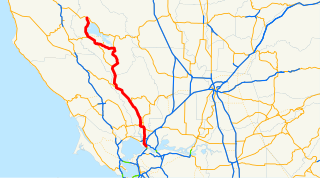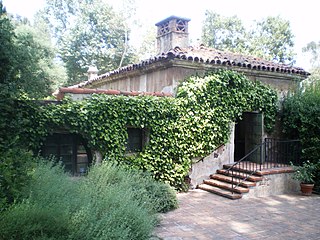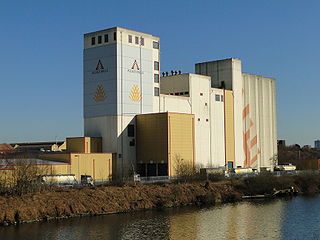
Napa is the largest city and the county seat of Napa County. It is the principal city of the Napa County Metropolitan Statistical Area, with a population of 78,130 as of the 2019 United States census estimate. It is the second-largest city in California's Wine Country, after Santa Rosa. Napa was incorporated as a city in 1872.

The Native Sons of the Golden West is a fraternal service organization founded in 1875, dedicated to historic preservation, documentation of historic structures and places in the state, the placement of historic plaques and other charitable functions within California. In 1890 they placed the first historical marker in the state to honor the discovery of gold which gave rise to the state nickname "Golden State" and "Golden West." Former U.S. President Richard M. Nixon and former Chief Justice of the United States Earl Warren were both past presidents of the NSGW.
William Whittingham Lyman was the son of Theodore Benedict Lyman. He built the Lyman winery, now known as the El Molino winery. At one point Lyman owned the property of what is now the Bale Grist Mill State Historic Park. He helped found Grace Episcopal Church of St. Helena, California. Lyman was a Lieutenant Colonel in the State militia, and was a member of Governor Bartlett's staff and an Aide-de-camp. He was married in Sacramento, in 1880, to Mrs. Sarah A. Nowland. They had two sons: Theodore Benedict, Jr. and William Whittingham Lyman Jr.

State Route 29 is a state highway in the U.S. state of California that travels from Interstate 80 in Vallejo north to State Route 20 in Upper Lake. It serves as the primary road through the Napa Valley, providing access to the Lake County region to the north and the rest of the San Francisco Bay Area to the south.

Bothe-Napa Valley State Park is a state park of California in the United States. Located in the Napa Valley, it contains the farthest inland coast redwoods in a California state park. The 1,991-acre (806 ha) park was established in 1960.

Babcock State Park is a state park located along the New River Gorge on 4,127 acres (16.7 km2) wooded in Fayette County, West Virginia. It is located approximately 20 miles away from the New River Gorge Bridge.

Kirby's Mill is a historic grist mill in Medford, Burlington County, New Jersey, United States. Originally known as Haines Mill, it was built in 1778 by Isaac Haines and partners along the Southwest Branch of Rancocas Creek. It was the last commercial operating mill in New Jersey.

The Andrew Zirkle Mill is a 1760s era grist mill located in the southern end of Shenandoah County, Virginia. The mill was added to the National Register of Historic Places in 1983 after being restored by Glenn Hofecker, the owner at the time. The mill is cited as a prime example of the architecture and construction of grist mills and manufacturing facilities of its era.

Robert Louis Stevenson State Park is a California state park, located in Sonoma, Lake and Napa counties. The park offers a 5-mile (8 km) hike to the summit of Mount Saint Helena from which much of the Bay Area can be seen. On clear days it is possible to see the peak of Mount Shasta, 192 miles (310 km) distant.

Florence Mill, also known as the Weber Mill, is a historic mill located at 9102 North 30th Street near the 30th Street exit on I-680 in the Florence community in North Omaha, Nebraska. It was built in 1846 and operated into the 1960s. It was listed on the National Register of Historic Places as Weber Mill in 1998. The mill is also known as the Mormon Mill, Grist Mill, and Old Pink Mill. It is now operated as the Winter Quarters Mill Museum and ArtLoft Gallery.

Roaring Fork is a stream in the Great Smoky Mountains of Tennessee, located in the Southeastern United States. Once the site of a small Appalachian community, today the stream's area is home to the Roaring Fork Motor Nature Trail and the Roaring Fork Historic District.

Patapsco Valley State Park is a public recreation area extending along 32 miles (51 km) of the Patapsco River south and west of the city of Baltimore, Maryland. The state park encompasses multiple developed areas on over 14,000 acres (5,700 ha) of land. In 2006, it was officially celebrated as Maryland's first state park and is managed by the Maryland Department of Natural Resources.

El Molino Viejo, also known as The Old Mill, is a former grist mill in the San Rafael Hills of present-day San Marino, California, United States, and was built in 1816 by Father José María de Zalvidea from the Mission San Gabriel Arcángel. It is the oldest commercial building in Southern California, and was one of the first ten sites in Los Angeles County to be listed on the National Register of Historic Places, receiving the recognition in 1971. The Old Mill has also been designated as a California Historical Landmark.
Rancho Carne Humana was a 17,962-acre (72.69 km2) Mexican land grant in present-day Napa County, California, given in 1841 by Governor Juan Alvarado to Edward Turner Bale. The name means "human flesh" in Spanish. There is speculation as to why the name was chosen. The grant was originally known to the native residents as "Huilic Noma" and also "Colijolmanoc". One naming theory speculates that Bale, in a bit of black humor, twisted "Colijolmanoc" into the similar-sounding Spanish "Carne Humana". Rancho Carne Humana was at the northern end of the Napa Valley, stretching from present-day Rutherford northward to Calistoga, ending at Tubbs Lane and including present-day St. Helena.

A gristmill grinds cereal grain into flour and middlings. The term can refer to either the grinding mechanism or the building that holds it. Grist is grain that has been separated from its chaff in preparation for grinding.

Gaston's Mill-Lock No. 36, Sandy and Beaver Canal District, is a historic district listed in the National Register of Historic Places. The district is located within Beaver Creek State Park, approximately 1 mile south of Clarkson, Ohio. Gaston's Mill was constructed in 1837 and was powered by Little Beaver Creek. Lock 36 was one of 90 locks on the Sandy and Beaver Canal. Construction of this canal began in 1834 but was not completed until 1848.

Great Valley Mill, also known as the Old Grist Mill in the Great Valley, is a historic grist mill located in Tredyffrin Township, Chester County, Pennsylvania. It was built in 1859, and is a four-story, rectangular banked stuccoed fieldstone structure. It measures 42 feet (13 m) by 45.5 feet (13.9 m), and has a gable roof. It was listed on the National Register of Historic Places in 1983.

Benson Grist Mill is a restoration-replica museum located in Tooele County, Utah in the western United States, which allows visitors to see the inner workings of a latter-nineteenth-century pioneer gristmill. It has four other historic (nineteenth-century) buildings which have been moved onto the site, as well as four ancillary structures, including an open-air pavilion. It covers 6.98 acres along State Highway 138, 0.8 mile southwest of the intersection of the Road with State Highway 36. The museum is owned and operated by a division of Tooele County.

The Whited Grist Mill is a historic gristmill located at the National Route 66 & Transportation Museum in Elk City, Oklahoma. Ruben Whited built the mill in 1903-04; his family operated the mill for its entire existence. The mill ground corn for Elk City's residents; a sign painted on the outside advertises "CORN GROUND INTO MEAL OR CHOPS AT ANY TIME". A 1928 addition brought a flour mill to the complex as well. The mill closed in 1944 due to replacement machinery shortages during World War II; it was the only gristmill to ever operate in Elk City. In 1985, the mill moved from its original site at 306 E. 7th St. to its current location.






















